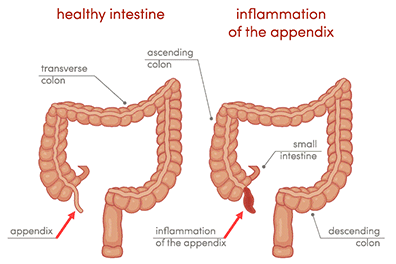The appendix is a narrow tube of intestine that extends from the cecum. Appendicitis (ap·pen·di·ci·tis) means the appendix is infected and inflamed. Acute appendicitis can cause abdominal pain and is the most common childhood surgical emergency. The pediatric surgeons at Children’s Health℠ typically remove the appendix using a minimally invasive method called laparoscopy. This procedure uses three small incisions and a camera called a laparoscope to look inside the abdomen during the operation.
Overview
What is pediatric appendicitis?

Annually, thousands of cases of pediatric appendicitis occur in the U.S, and it occurs in all ages of children.
The inflammation and infection of the appendix triggers obstructions of drainage and blood flow, leading to destruction of the appendix. Without intervention, infection can spread beyond the appendix, potentially resulting in peritonitis – a serious condition.
Signs and Symptoms
What are the signs and symptoms of pediatric appendicitis?
The most common symptom is abdominal pain, which may start in the area around the belly button and move to the lower right-hand side of the abdomen. Other symptoms include low-grade fever and vomiting. Symptoms might not show up in children. Delayed diagnosis increases the risk of rupture and its serious complications.
Treatment
How is pediatric appendicitis treated?
Surgery (appendectomy)
The pediatric surgeons will typically remove the appendix using a minimally invasive method called a laparoscopy.
A child whose appendix ruptured will have to stay in the hospital longer than the child whose appendix was removed before it ruptured. Some children will need to take oral antibiotics for a period of time specified by the physician after they go home.
Doctors and Providers
 Adam Craig AlderPediatric Surgeon
Adam Craig AlderPediatric Surgeon Nathalie BrewerPediatric Surgeon
Nathalie BrewerPediatric Surgeon Natasha Marie CorbittPediatric Surgeon
Natasha Marie CorbittPediatric Surgeon Diana Leigh DiesenPediatric Surgeon
Diana Leigh DiesenPediatric Surgeon Barbara Anne GainesPediatric Surgeon
Barbara Anne GainesPediatric Surgeon Lauren Ann GilloryPediatric Surgeon
Lauren Ann GilloryPediatric Surgeon Russell HawkinsPediatric Surgeon
Russell HawkinsPediatric Surgeon Charles Robert HongPediatric Surgeon
Charles Robert HongPediatric Surgeon Stephen Mark MegisonPediatric Surgeon
Stephen Mark MegisonPediatric Surgeon Carrie Colleen Buchanan MoorePediatric Surgeon
Carrie Colleen Buchanan MoorePediatric Surgeon Joseph Thomas MurphyPediatric Surgeon
Joseph Thomas MurphyPediatric Surgeon Samir R PandyaPediatric Surgeon
Samir R PandyaPediatric Surgeon Laura Nanka PurcellPediatric Surgeon
Laura Nanka PurcellPediatric Surgeon Faisal Ghulam QureshiPediatric Surgeon
Faisal Ghulam QureshiPediatric Surgeon